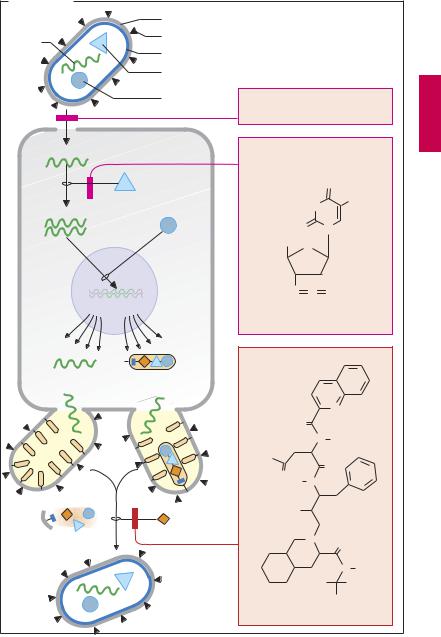
- •Preface to the 3rd edition
- •General Pharmacology
- •Systems Pharmacology
- •Therapy of Selected Diseases
- •Subject Index
- •Abbreviations
- •General Pharmacology
- •History of Pharmacology
- •Drug and Active Principle
- •The Aims of Isolating Active Principles
- •European Plants as Sources of Effective Medicines
- •Drug Development
- •Congeneric Drugs and Name Diversity
- •Oral Dosage Forms
- •Drug Administration by Inhalation
- •Dermatological Agents
- •From Application to Distribution in the Body
- •Potential Targets of Drug Action
- •External Barriers of the Body
- •Blood–Tissue Barriers
- •Membrane Permeation
- •Binding to Plasma Proteins
- •The Liver as an Excretory Organ
- •Biotransformation of Drugs
- •Drug Metabolism by Cytochrome P450
- •The Kidney as an Excretory Organ
- •Presystemic Elimination
- •Drug Concentration in the Body as a Function of Time—First Order (Exponential) Rate Processes
- •Time Course of Drug Concentration in Plasma
- •Time Course of Drug Plasma Levels during Repeated Dosing (A)
- •Time Course of Drug Plasma Levels during Irregular Intake (B)
- •Accumulation: Dose, Dose Interval, and Plasma Level Fluctuation (A)
- •Dose–Response Relationship
- •Concentration–Effect Curves (B)
- •Concentration–Binding Curves
- •Types of Binding Forces
- •Agonists—Antagonists
- •Other Forms of Antagonism
- •Enantioselectivity of Drug Action
- •Receptor Types
- •Undesirable Drug Effects, Side Effects
- •Drug Allergy
- •Cutaneous Reactions
- •Drug Toxicity in Pregnancy and Lactation
- •Pharmacogenetics
- •Placebo (A)
- •Systems Pharmacology
- •Sympathetic Nervous System
- •Structure of the Sympathetic Nervous System
- •Adrenergic Synapse
- •Adrenoceptor Subtypes and Catecholamine Actions
- •Smooth Muscle Effects
- •Cardiostimulation
- •Metabolic Effects
- •Structure–Activity Relationships of Sympathomimetics
- •Indirect Sympathomimetics
- •Types of
- •Antiadrenergics
- •Parasympathetic Nervous System
- •Cholinergic Synapse
- •Parasympathomimetics
- •Parasympatholytics
- •Actions of Nicotine
- •Localization of Nicotinic ACh Receptors
- •Effects of Nicotine on Body Function
- •Aids for Smoking Cessation
- •Consequences of Tobacco Smoking
- •Dopamine
- •Histamine Effects and Their Pharmacological Properties
- •Serotonin
- •Vasodilators—Overview
- •Organic Nitrates
- •Calcium Antagonists
- •ACE Inhibitors
- •Drugs Used to Influence Smooth Muscle Organs
- •Cardiac Drugs
- •Cardiac Glycosides
- •Antiarrhythmic Drugs
- •Drugs for the Treatment of Anemias
- •Iron Compounds
- •Prophylaxis and Therapy of Thromboses
- •Possibilities for Interference (B)
- •Heparin (A)
- •Hirudin and Derivatives (B)
- •Fibrinolytics
- •Intra-arterial Thrombus Formation (A)
- •Formation, Activation, and Aggregation of Platelets (B)
- •Inhibitors of Platelet Aggregation (A)
- •Presystemic Effect of ASA
- •Plasma Volume Expanders
- •Lipid-lowering Agents
- •Diuretics—An Overview
- •NaCl Reabsorption in the Kidney (A)
- •Aquaporins (AQP)
- •Osmotic Diuretics (B)
- •Diuretics of the Sulfonamide Type
- •Potassium-sparing Diuretics (A)
- •Vasopressin and Derivatives (B)
- •Drugs for Gastric and Duodenal Ulcers
- •Laxatives
- •Antidiarrheal Agents
- •Drugs Affecting Motor Function
- •Muscle Relaxants
- •Nondepolarizing Muscle Relaxants
- •Depolarizing Muscle Relaxants
- •Antiparkinsonian Drugs
- •Antiepileptics
- •Pain Mechanisms and Pathways
- •Eicosanoids
- •Antipyretic Analgesics
- •Nonsteroidal Anti-inflammatory Drugs (NSAIDs)
- •Cyclooxygenase (COX) Inhibitors
- •Local Anesthetics
- •Opioid Analgesics—Morphine Type
- •General Anesthesia and General Anesthetic Drugs
- •Inhalational Anesthetics
- •Injectable Anesthetics
- •Sedatives, Hypnotics
- •Benzodiazepines
- •Pharmacokinetics of Benzodiazepines
- •Therapy of Depressive Illness
- •Mania
- •Therapy of Schizophrenia
- •Psychotomimetics (Psychedelics, Hallucinogens)
- •Hypothalamic and Hypophyseal Hormones
- •Thyroid Hormone Therapy
- •Glucocorticoid Therapy
- •Follicular Growth and Ovulation, Estrogen and Progestin Production
- •Oral Contraceptives
- •Antiestrogen and Antiprogestin Active Principles
- •Aromatase Inhibitors
- •Insulin Formulations
- •Treatment of Insulin-dependent Diabetes Mellitus
- •Treatment of Maturity-Onset (Type II) Diabetes Mellitus
- •Oral Antidiabetics
- •Drugs for Maintaining Calcium Homeostasis
- •Drugs for Treating Bacterial Infections
- •Inhibitors of Cell Wall Synthesis
- •Inhibitors of Tetrahydrofolate Synthesis
- •Inhibitors of DNA Function
- •Inhibitors of Protein Synthesis
- •Drugs for Treating Mycobacterial Infections
- •Drugs Used in the Treatment of Fungal Infections
- •Chemotherapy of Viral Infections
- •Drugs for the Treatment of AIDS
- •Drugs for Treating Endoparasitic and Ectoparasitic Infestations
- •Antimalarials
- •Other Tropical Diseases
- •Chemotherapy of Malignant Tumors
- •Targeting of Antineoplastic Drug Action (A)
- •Mechanisms of Resistance to Cytostatics (B)
- •Inhibition of Immune Responses
- •Antidotes and Treatment of Poisonings
- •Therapy of Selected Diseases
- •Hypertension
- •Angina Pectoris
- •Antianginal Drugs
- •Acute Coronary Syndrome— Myocardial Infarction
- •Congestive Heart Failure
- •Hypotension
- •Gout
- •Obesity—Sequelae and Therapeutic Approaches
- •Osteoporosis
- •Rheumatoid Arthritis
- •Migraine
- •Common Cold
- •Atopy and Antiallergic Therapy
- •Bronchial Asthma
- •Emesis
- •Alcohol Abuse
- •Local Treatment of Glaucoma
- •Further Reading
- •Further Reading
- •Picture Credits
- •Drug Indexes

290 Antiviral Drugs
Drugs for the Treatment of AIDS
Replication of the human immunodeficiency virus (HIV), the causative agent of AIDS, is susceptible to targeted interventions because it entails several obligatory steps in virus-specific metabolism (A). First, the virus docks at the CD4 complex of T-helper lymphocytes by means of a glycoprotein in the viral coat (p.304). A fusion protein is then extruded from the viral coat, by which fusion of the latter and the cell membrane is initiated. Next, viral RNA is transcribed into DNA, a step catalyzed by viral “reverse transcriptase.” Double-stranded DNA is incorporated into the host genome with the help of viral integrase. Under control by viral DNA, viral replication can then be initiated, with synthesis of viral RNA and proteins (including enzymes such as reverse transcriptase and integrase, and structural proteins such as the matrix protein lining the inside of the viral envelope). These proteins are not assembled individually but in the form of polyproteins. An N-terminal fatty acid (myristoyl) residue promotes their attachment to the interior face of the plasmalemma. As the virus particle buds off the host cell, it carries with it the affected membrane area as its envelope. During this process, a protease contained within the polyprotein cleaves the latter into individual functionally active proteins.
I. Inhibitors of Reverse Transcriptase— Nucleoside Agents
Representatives of this group include zidovudine, stavudine, zalcitabine, didanosine, and lamivudine. They are nucleosides containing an abnormal sugar moiety and require bioactivation by phosphorylation (cf. zidovudine in A). As triphosphates, they inhibit reverse transcriptase and cause strand breakage following incorporation into viral DNA. The substances are administered orally. In part, they differ in their spectrum of adverse effects (e.g., leukopenia with zidovudine; peripheral neuropathy and pancreatitis with the others) and in the mechanisms
responsible for development of resistance. AIDS therapy mostly employs combinations of two members of this group plus either a nonnucleoside inhibitor (see below) or one to two protease inhibitors (see below).
Nonnucleoside Inhibitors
Nevirapine and efavirenz are active inhibitors of reverse transcriptase, that is, they do not require phosphorylation. Adverse reactions include rashes and interactions involving cytochrome P450 isozymes (CYP).
II. HIV protease Inhibitors
Inhibitors of viral protease prevent cleavage of inactive precursor proteins, and hence viral maturation. They are administered orally.
Saquinavir could be considered an abnormal peptide. Its bioavailability is low. Ritonavir, indinavir, nelfinavir, and amprenavir are other protease inhibitors that in part exhibit markedly higher bioavailability. Biotransformation of these drugs involves CYP enzymes and is therefore subject to interaction with various other drugs metabolized via this route. Prolonged administration may be associated with a peculiar redistribution of adipose tissue and metabolic disturbances (hyperlipidemia, insulin resistance, hyperglycemia).
III. Fusion Inhibitors
Enfuvirtide is a peptide that binds to the viral fusion protein in such a manner as to prevent the necessary change in conformation. It is a reserve drug.

Drugs for the Treatment of AIDS |
291 |
A. AIDS drugs |
|
|
|
|
|
|
Envelope |
|
|
|
|
RNA |
Fusion glycoprotein |
|
|
|
|
|
|
|
|
|
|
|
Matrix protein |
|
|
|
|
|
Reverse |
|
|
|
|
|
transcriptase |
|
|
|
|
|
Integrase |
Fusion inhibitor Enfuvirtide, |
|||
|
|
||||
|
|
a peptide, s.c. administration |
|||
Viral RNA |
|
Inhibitors of |
|
|
|
|
reverse |
|
|
|
|
|
|
|
|
|
|
|
|
transcriptase |
|
|
|
|
|
|
|
|
O |
|
|
|
|
H N |
CH 3 |
DNA |
|
|
|
|
|
|
|
|
|
|
|
|
|
|
O |
N |
|
|
|
HOCH2 |
O |
|
|
|
|
|
N |
+ |
N – |
|
|
|
N |
||
|
|
e.g., zidovudine |
|
||
|
|
Inhibitors of |
|
|
|
Viral RNA |
Polyproteins |
HIV protease |
|
|
|
|
|
|
|
||
|
|
|
|
|
N |
|
|
|
O |
|
|
|
|
|
|
N |
H |
|
|
H2N |
|
|
O |
|
|
O |
|
|
|
|
|
H |
N |
|
|
|
|
|
|
||
|
Protease |
HO |
|
|
|
|
|
|
|
|
|
Polyprotein |
|
|
|
N |
O |
cleavage |
|
|
|
|
|
|
|
|
|
|
|
|
|
|
|
|
N H |
|
|
|
|
H3C |
CH3 |
|
Mature virus |
e.g., saquinavir |
CH3 |
||
|
|
||||

292 Antiparasitic Drugs
Drugs for Treating Endoparasitic and Ectoparasitic Infestations
Adverse hygienic conditions favor human infestation with multicellular organisms (referred to here as parasites). Skin and hair are colonization sites for arthropod ectoparasites, such as insects (lice, fleas) and arachnids (mites). Against these, insecticidal and arachnicidalagents,respectively,canbeused. Endoparasites invade the intestines or even internal organs and are mostly members of the phyla of flatworms and roundworms. They are combated with anthelmintics.
Antihelmintics. As shown in the table, the newer agents, praziquantel and mebendazole, are adequate for the treatment of diverse worm diseases. They are generally well tolerated, as are the other agents listed.
Insecticides. Whereasfleascanbeeffectively dealtwithbydisinfectionofclothesandliving quarters, lice and mites require the topical applicationofinsecticidestotheinfestedsubject.Thefollowingagentsactmainlybyinterfering with the activation or inactivation of neuralvoltage-gatedinsectsodiumchannels.
Chlorphenothane (DDT) kills insects after absorptionofaverylowamount,e.g.,viafoot contact with sprayed surfaces (contact insec-
ticide). The cause of death is nervous system damage and seizures. In humans DDT causes acute neurotoxicity only after absorption of very large amounts. DDT is chemically stable and is degraded in the environment and the body at extremely slow rates. As a highly lipophilic substance, it accumulates in fat tissues. Widespread use of DDT in pest control has led to its accumulation in food chains to alarming levels. For this reason its use has now been banned in many countries.
Lindane is the active γ-isomer of hexachlorocyclohexane. It also exerts a neurotoxic action on insects (as well as humans). Irritation of skin or mucous membranes may occur after topical use. Lindane is active also against intradermal mites (Sarcoptes scabiei, causative agent of scabies), besides lice and fleas. Although it is more readily degraded than DDT, it should be used only as a secondline agent with appropriate precautions. In the United Kingdom its use for head lice has been banned; in the United States it is not recommended in young children and is contraindicated in premature infants.
Permethrin, a synthetic pyrethroid, exhibits similar antiectoparasitic activity and may be the drug of choice owing to its slower cutaneous absorption, fast hydrolytic inactivation, and rapid renal elimination.
Therapy of Worm Infestations |
|
|
|
Worms (helminths) |
Anthelminthic Drug of Choice |
|
|
Flatworms (platyhelminths) |
|
Tape worms (cestodes) |
Praziquantela or niclosamide |
Flukes (trematodes), |
Praziquantel |
e.g., Schistosoma species (bilharziasis) |
|
|
|
Roundworms (nematodes) |
|
Pinworm (Enterobius vermicularis) |
Mebendazole or pyrantel pamoate |
Whipworm (Trichuris trichiura) |
Mebendazole |
Ascaris lumbricoides |
Mebendazole or pyrantel pamoate |
Trichinella spiralisb |
Mebendazole and thiabendazole |
Strongyloides stercoralis |
Thiabendazole |
Hookworms (Necator americanus, |
Mebendazole or pyrantel pamoate |
Ancylostoma duodenale) |
|
|
|
a Not for ocular or spinal cord cysticercosis. |
|
b Thiabendazole in intestinal phase; mebendazole in tissue phase.

|
Drugs against Endoand Ectoparasites |
293 |
A. Endoparasites and ectoparasites: therapeutic agents |
|
|
Tapeworms |
Louse |
|
e.g., beef |
|
|
tapeworm |
|
|
Spasm, |
|
|
|
|
|
|
Cl |
|
|
injury of |
|
|
|
|
|
|
|
|
|
integument |
|
|
|
|
|
|
|
|
|
O |
C |
|
|
|
|
Chlor- |
|
Cl |
|
|
N |
|
|
|
|
HC |
C |
Cl |
|
|
|
|
|
|
phenothane |
||||
|
N |
|
|
|
|
(DDT) |
|
Cl |
|
|
|
O |
|
|
death |
|
|
|
|
|
|
|
Praziquantel |
Cl |
|
|
|||
|
|
|
|
|
|
||||
|
|
|
|
|
|
convulsions, |
|
|
|
Round- |
|
|
|
|
|
|
|
|
|
worms, |
|
|
|
|
|
|
|
|
|
e.g., |
|
|
|
|
|
system:nervousto |
|
|
|
ascaris |
|
|
|
|
|
|
|
|
|
|
|
|
|
|
|
|
|
|
|
|
|
Pinworm |
|
|
Flea |
|
|
|
|
O |
|
|
|
|
|
Damage |
Cl |
|
|
|
|
|
|
|
|
|
|
||
|
|
|
|
|
Cl |
|
|
Cl |
|
C |
|
|
|
|
|
|
|
||
|
|
NH |
|
|
|
|
|
|
|
|
|
N |
NH |
COOC |
3 |
Cl |
|
|
Cl |
|
|
|
|
Cl |
|
|
|||
|
|
|
|
H |
|
|
|
|
|
|
|
|
|
|
|
Hexachlorocyclo- |
|||
Mebendazole |
|
|
|
|
hexane (Lindane) |
||||
Trichinella |
|
larvae |
Scabies mite |
